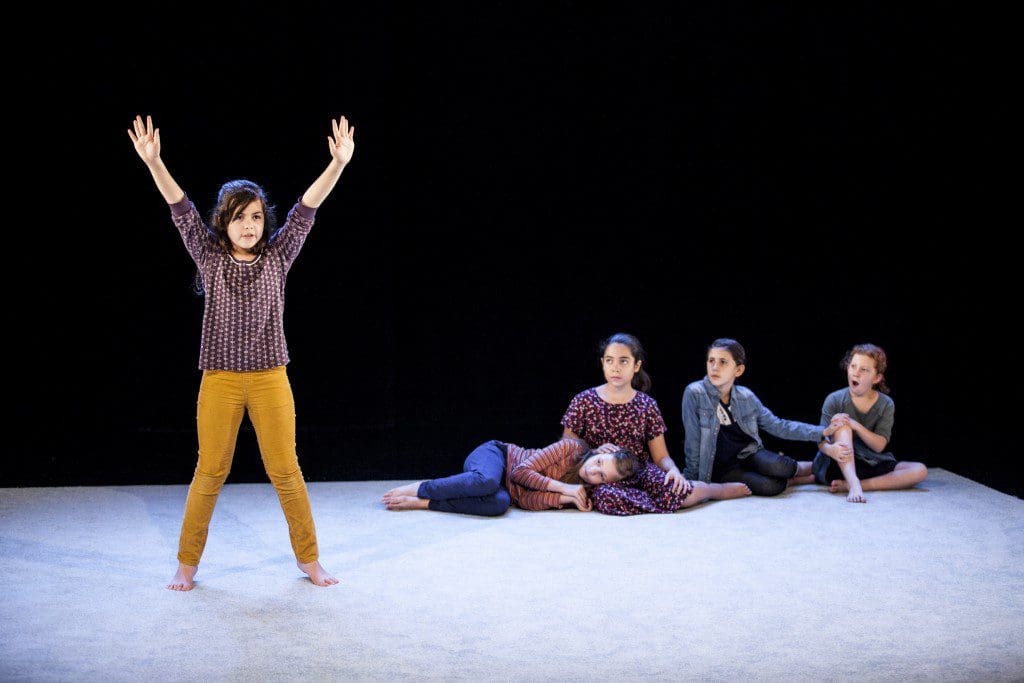“Working With the Surface”: Specificity and Universality in Employee of the Year
As theatergoers, we are trained to suspend our disbelief each time the house lights go down. Until they rise again our phones are to remain off and we are expected to immerse ourselves in the story, to embrace its world as a reality, to pretend that that woman on stage is in fact a mother of three with a heart murmur and a deadbeat husband, not the person you sat next to on the trolley last week who graciously offered you a napkin when you spilled coffee all over your sick new Spacemen 3 shirt (the napkin couldn’t save it, but it was a nice gesture all the same). It’s a sentiment that’s easier to embrace for some productions than others, but of course even the greatest works of theater cannot manage to make us forget we are witnessing just that, theater. After all, how can they expect to when the competition can be an insistent bladder or a wheezing attendee sitting behind you? More to the point though, they can never truly fool us into believing the actors are their characters. “Blankness is, indeed, impossible,” Abigail Browde, half of the Brooklyn-based theater company 600 HIGHWAYMEN, recently told BOMB Magazine, ruminating on the misconceived notion of the actor as an empty vessel for character. “It’s a false premise to imagine that it’s possible to be blank, bare, empty. But falseness as an idea must be addressed when you’re working in theater.”
This weekend 600 HIGHWAYMEN bring their universally acclaimed show Employee of the Year to FringeArts, with just two performances on February 26 and 27. The work recounts the life story of a woman named J, starting at age 3 and continuing through to 80. However, what in summation bears resemblance to the journey myths that inspired it—a brisk, but affecting tale of a life marked by struggle and heartbreak—transcends its already gripping story arc when one witnesses it being told by its five performers, all of whom are under the age of 13. Blankness is obviously impossible when an eleven-year-old is narrating the concerns of an elderly woman in the first person.
J’s childhood flies by in the play’s first few minutes, a series of brief snapshots—pick-up sticks, kites, separation anxiety—before it all, quite literally, goes up in smoke. The brisk manner in which the story eclipses its performers’ life experiences may at first strike viewers as jarring, but that is just part of the show’s magic. This ever-growing age difference between subject and performers renders each detail of J’s life that much starker, the visible contrast pointing to the rift between the (assumed) infinite potentials of youth and the harsh realities that tend to quell them with a rarely glimpsed immediacy and presence. “We’re always looking to find ways to illuminate that gap between performer and character,” Browde told FringeArts in a recent interview, going on to assert, “Traditional acting asks actors to transform into a character, but in our work, we’re more interested in things that don’t easily fit together. I’m not against transformation—in fact transformation is part of our agenda—but we do it from a different door.”

Michael Silverstone and Abigail Browde of 600 Highwaymen (Photo by Simon Courchel)
What this strategy translates into for the viewer is a kind of personally perceived transformation. Rather than force a notion of embodiment with the usual hallmarks of theatrical productions—sets, costumes, straightforward character portrayals—Browde and her creative partner Michael Silverstone (the other half of 600 HIGHWAYMEN) have stripped these trappings away, giving the audience room to fill in the gaps themselves. On a set composed of a large patch of white carpet, we are told by the performers where we are at every turn in the story. Rather than showing us J’s childhood home, her yard, a bus, we are given the space to create the image for ourselves, a prompt which undoubtedly causes us to draw on our own experiences and associations. This approach—coupled with the abstract, entrancing, projection-ready choreography— works astoundingly well to gradually immerse the audience. However, it can be wielded just as impressively to snap us back at expertly hewn moments, incidents that remind us we are witnessing a remarkably mature work of art being carried by performers who are still years away from getting behind the wheel of a car. It’s a testament to the high standard of craft that went into Employee of the Year that it can run such an emotional and experiential gamut without calling too much attention to its subtle moving parts. One the most affecting of these are the deceptively simple, original songs from legendary writer/performer David Cale.
A veteran artist in New York and beyond, Cale has made a mark on the contemporary performance world with works such as The Redthroats, Palomino, and the Obie Award-winning Lillian, all of which find him in his most familiar mode: alone onstage with little-to-no set decoration or costume, telling stories directly to the audience. As a revered talent who has built a career stripping away the dressings of traditional theater to remarkable effect, his involvement with Employee of the Year makes perfect sense, and thankfully Browde and Silverstone had the good sense to work with him as a collaborator rather than simply a hired hand. It’s a creative partnership that pays off tremendously. “[Cale] came and watched rehearsals for a while before bringing in any songs,” according to Browde. “It wasn’t that we had a script done and we said, ‘Right. We need a song here, here and here.’ We were all writing concurrently… and David truly wrote the songs for each girl, for their voice and who they are as a person and a performer.” As a result, the songs effortlessly weave in and out of the narrative and worm their way into your head where they will undoubtedly echo long after the girls take their bows.
In the aforementioned interview with BOMB, Michael Silverstone mentions a quote from photographer Richard Avedon on the subjects of his American West series: “You can’t get at the thing itself, the real nature of the sitter, by stripping away the surface. The surface is all you’ve got. You can only get beyond the surface by working with the surface.” Conventional production strategies find theater makers disguising the surface, but postmodern works like Employee of the Year directly engage it. Rather than making art that imitates life, Browde and Silverstone seek to instead reflect it, to create a scenario in which there is room for the audience to ruminate on their own lives, on personal truths that no one else could possibly reach. There is remarkable specificity to the show in the way each line, movement, and lyric was crafted to each performer’s particular style, yet there is still something profoundly universal and applicable to all. Perhaps it’s rooted in our tendency to project our own traits onto children, perhaps in the mind’s habit of reaching to fill in the work’s carefully placed gaps. Though the experience may be different for each viewer, there is no doubt that it’s one that should not be missed by any.
—Hugh Wilikofsky



